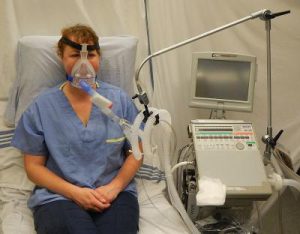
Engineering researchers from the University of Warwick and their team have used computational modelling to illustrate that non-invasive respiratory support has a greater chance of being successful if it allows reductions in the breathing efforts of patients. They compared the effectiveness of Conventional Oxygen Therapy (COT), High-Flow Nasal Oxygen Therapy (HFNOT), Continuous Positive Airway Pressure (CPAP), and Non-Invasive Ventilation (NIV).
In their paper published in the British Journal of Anaesthesia, they used computational simulations of 120 COVID-19 patients to illustrate the internal forces produced by different types of non-invasive support at different levels of breathing effort.
The researchers and their team of experts found that although non-invasive support improved oxygenation of patients, it caused the stress and strain on the lungs to increase to potentially damaging levels unless there was a significant reduction in breathing effort.
As a result of the many risks associated with mechanical ventilations, many COVID-19 patients are treated with CPAP, HFNOT or NIV. Clinical trials are still going on to discover why some patients respond well to the non-invasive therapies while some deteriorate and later require mechanical ventilation.
Declan Bates, Professor from the School of Engineering at the University of Warwick said, ‘Many COVID-19 patients who experience acute respiratory failure are initially treated using some form of non-invasive respiratory support to help them breathe and avoid the need for mechanical ventilation. This study shows the power of computational simulation to rapidly answer questions that are directly relevant to the treatment of critically ill patients.’
Dr. Luigi Camporta, co-author of the study said, ‘There is concern that strenuous breathing can further damage the lungs of COVID-19 patients. Our study found that reductions in patients’ breathing efforts after commencing non-invasive respiratory support could be a key-indicator of its likely success. These results provide urgently needed evidence to help clinicians manage and optimize the treatment of COVID-19 patients in a way that averts additional and preventable lung injury.’
By Marvellous Iwendi.
Source: Warwick